Characterization Elements
Costumes, Make-up, Costume Design - Help Tell the Story!
Let's Play Dress-up! Costuming and Makeup
The party invitation said formal. Traditionally women are expected to arrive in gowns and the men in tuxedos. Today, however, the variations of each might be different, but the classification would be the common interpretation.
The same idea extends to stage productions. The costumes (style of dress) and makeup are designed and dictated by the play's author in the character descriptions.
The costumes are so important to the authenticity of the play presentation. They can make or break the idea to be communicated. If the character doesn't look the part, the audience cannot connect with the character to the dialog.
Proper Costuming and Makeup Maintains the Flow of the Imagination
The whole experience of the play is lost if the audience cannot relate to the story. That is why, so much time is put into dressing the actor to look authentic to the play.
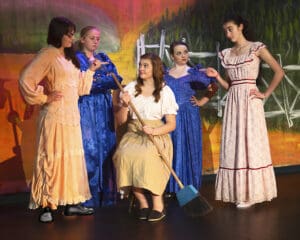
Cinderella Reprise - 2014
Another factor in costuming is how the actor portrays the character. If the actor is more physical on stage with the character, the costume must allow for that type of movement. If the actor is more prim and proper, likewise, the costume must relay a sophisticated image and sense to the audience.
Familiarity is the Key to Costuming
Costuming for plays that are well known must meet the 'expectations' of the audience. For example, Sherlock Holmes should have a pipe, a cape, and a deerstalker hat; Mary Poppins a hat with cherries, an umbrella, and a magical bag; Tevya (Fiddler on the Roof) a pull-cart, and Rafiki (The Lion King) a staff and long finger extensions.
Other examples of our Costume and Makeup design ideas are reflected in our shows – Cinderella Reprise, Broadway’s Guys and Dolls Jr., You’re a Good Man Charlie Brown,
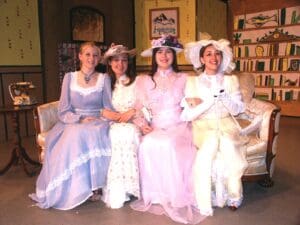
The Importance of Being Earnest - 2003
The Importance of Being Earnest, Disney’s Little Mermaid Jr., Disney’s Aladdin Jr., and headwear from Disney’s The Lion King Jr.
HINT: Review how other groups create imagination with their costuming and make-up tips, trick, and techniques. It seems that the same plays are performed all over the US and around the world and are known for their costuming and make-up. So “Why re-invent the wheel?” when you can glean inspiration.
In New Artists Productions we periodically have a workshop about make-up. These are often times conducted by retired professionals in our area, beauticians, Moms who have studied theater in college, etc.
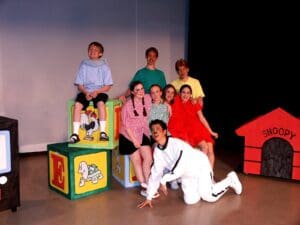
You're a Good Man, Charlie Brown - 2003
Or, the demonstration might be done by a make-up artist associated with a particular show - usually a talented parent. The project team will always find that “There are always resources for what we need, when we need them.”
Prime example of costuming from other sources:
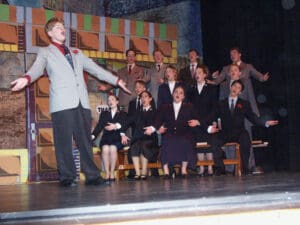 Guys and Dolls Jr. (2010) was such a fun experience for all of the actors and the audiences. Convincing the audience were the Hot Box girls in their dance routines; and, the gangsters and Missionaries highlight in the singing of "Sit Down, You're Rockin' the Boat." in the Mission. Each drew the audience in the scene - the task that they are supposed to do as actors on stage.
Guys and Dolls Jr. (2010) was such a fun experience for all of the actors and the audiences. Convincing the audience were the Hot Box girls in their dance routines; and, the gangsters and Missionaries highlight in the singing of "Sit Down, You're Rockin' the Boat." in the Mission. Each drew the audience in the scene - the task that they are supposed to do as actors on stage.
Authentic Costuming is Sometimes Provided

Guys and Dolls Jr. - Hot Box Dancers - 2010
The Salvation Army uniforms authentic and on loan from the local facility. The mannerisms of the Ladies were also taught to make everything real.
The Hot Box Girls dresses were on loan from the theater costume loft. So, yet another resource for costumes.
Learning About Make-Up
In New Artists Productions our make-up workshops introduce the young actors and their parents to the techniques of disguise and beautification.
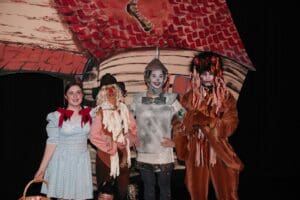
The Wizard of Oz Four - 2004
The beauty is that once the kids learn about the techniques, they become our make-up techs for the production.
It is amazing how interested everyone becomes, once they are shown how it is done – even the boys in our program apply their own makeup in shows and serve as techs for the younger performers. It is a skill that will serve them throughout their theatrical careers.

These two young actors shared the role of Renfield in our Dracula (2005) production. Each brought a different personality and movement to the role which made it interesting for the other cast members as they had to adjust to the voice inflections and the antics that each brought. Truly a valuable learning experience for everyone!
Character Transformation through Makeup Techniques 
"We received these photos from the family who transformed their daughter into the male character Sherlock Holmes for our Fall 2012 production. The make-up artist was the Mother of the actor.
It is always fun to see how other theater groups accomplish their Staging - gleaning information that is available is 'a welcome technique to stir Imagination and Creativity.'
